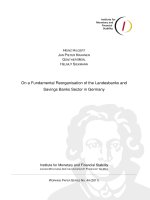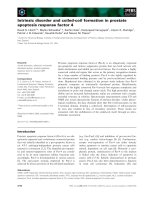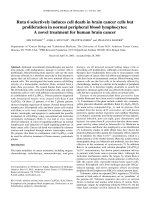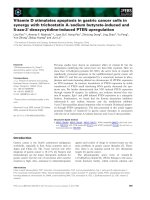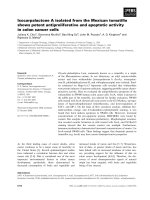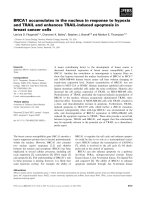Proscillaridin A induces apoptosis, inhibits STAT3 activation and augments doxorubicin toxicity in prostate cancer cells
Bạn đang xem bản rút gọn của tài liệu. Xem và tải ngay bản đầy đủ của tài liệu tại đây (1.14 MB, 8 trang )
Int. J. Med. Sci. 2018, Vol. 15
Ivyspring
International Publisher
832
International Journal of Medical Sciences
2018; 15(8): 832-839. doi: 10.7150/ijms.23270
Research Paper
Proscillaridin A induces apoptosis, inhibits STAT3
activation and augments doxorubicin toxicity in prostate
cancer cells
Yangyang He1, Muhammad Khan2, Jingbo Yang3, Min Yao1, Shili Yu1, Hongwen Gao1
1.
2.
3.
Department of Pathology, the Second Hospital of Jilin University, Changchun 130041, P.R. China.
Department of Zoology, University of the Punjab, Quaid-e-Azam Campus Lahore 54590, Pakistan.
Jilin Provincial Key Laboratory on Molecular and Chemical Genetics, the Second Hospital of Jilin University, Changchun 130041, P.R. China.
Corresponding author: Hongwen Gao, Department of Pathology, the Second Hospital of Jilin University, Changchun 130041, P.R. China. Email:
© Ivyspring International Publisher. This is an open access article distributed under the terms of the Creative Commons Attribution (CC BY-NC) license
( See for full terms and conditions.
Received: 2017.10.11; Accepted: 2018.04.12; Published: 2018.05.22
Abstract
Cardiac glycosides are natural compounds used for the treatment of congestive heart failure and
cardiac arrhythmias. Recently, they have been reported to exhibit anticancer activity. Proscillaridin
A (PSN-A), a cardiac glycoside constituent of Urginea maritima has been shown to exhibit anticancer
activity. However, the cellular targets and anticancer mechanism of PSN-A in various cancers
including prostate cancer remain largely unexplored. In the present study, we have shown that
PSN-A inhibits proliferation and induces apoptosis in prostate cancer cells in a dose-dependent
manner. Further mechanistic study have shown that anticancer activity of PSN-A in prostate cancer
cells is associated with ROS generation, Bcl-2 family proteins modulation, mitochondrial membrane
potential disruption and ultimately activation of caspase-3 and cleavage of PARP. Moreover, we
found that PSN-A inhibits JAK2/STAT3 signaling and augments doxorubicin toxicity in prostate
cancer cells. Of note, LNCaP cells were found to be more sensitive to PSN-A treatment as
compared to DU145 cells. Taken together, the data provided first evidence of the anticancer activity
and possible molecular mechanism of PSN-A in prostate cancer. Further study is needed to develop
PSN-A into a potential lead compound for the treatment of prostate cancer.
Key words: Cardiac glycosides, Proscillaridin A, Bcl-2, STAT3, Prostate cancer
Introduction
Prostate cancer is one of the most commonly
diagnosed malignancies and 2nd leading cause of
death in men worldwide [1]. At present, surgery,
radiotherapy, androgen deprivation therapy (ADT)
and chemotherapy are the available treatment options
for prostate cancer [1]. ADT is still the first line
treatment; however, most patients develop highly
aggressive castration-resistant prostate cancer 14-20
months post-ADT therapy for which the median
survival rate is less than 19 months [2, 3]. Thus,
chemotherapy remains the only choice for advanced
stage castration-resistant prostate cancer. Although,
chemotherapy with taxane improved the survival rate
of patients with metastatic castration-resistant
prostate cancer (MCRPC), the prognosis of MCRPC
still remains very poor [4, 5]. Therefore, exploring
novel bioactive molecules and their anticancer
mechanism is urgently needed for improving the
outcomes of prostate cancer treatment.
Cancer chemoprevention and treatment by
natural compounds has gained increasing attention
because it is believed to be safe, cheap and alternative
form of modern healthcare system. Natural products
have significantly contributed in discovery of
anticancer drugs. At present, more than 60% FDA
approved anticancer drugs have been derived from
natural products including medicinal plants. Plants
secondary metabolites such as vinca alkaloids and
Int. J. Med. Sci. 2018, Vol. 15
terpenes have been extensively studied for their
potential use in the treatment of various cancers [6, 7].
Cardiac glycosides are plants’ secondary metabolites
which have long been used to treat cardiac
congestions and cardiac arrhythmias. Although
originally prescribed to treat cardiac failure, more
recently they have been rediscovered for their
potential anticancer activity. Cardiac glycosides have
been reported to exhibit anticancer activity at
non-toxic concentration in various in vitro and in vivo
cancer models through multiple mechanisms
including inhibition of cell proliferation, induction of
apoptosis and augmentation of chemotherapy [8, 9].
In the present study, we have shown for the first time
that PSN-A, a cardiac glycoside component of Urginea
833
maritima [10] inhibits growth and induces
mitochondrial apoptosis in prostate cancer cells.
Moreover, we found that PSN-A inhibits JAK2/
STAT3 signaling and enhances anticancer activity of
doxorubicin in prostate cancer cells for the first time.
Materials and Methods
Antibodies and reagents
PSN-A (Figure 1A) was purchased from
EXTRASYNTHESE (Genay, France). Dulbecco’s
Modified Eagle’s Medium (DMEM) and fatal bovine
serum (FBS) were purchased from Gibco (Eggenstein,
Germany) while Penicillin/ Streptomycin antibiotics
was obtained from Solarbio co., Ltd. (Beijing, China).
Annexin
V-FITC/PI
double
staining
apoptosis detection kit, Reactive Oxygen
Species (ROS) assay kit, mitochondrial
membrane potential (MMP) assay kit, Crystal
violet, 3-(4,5-Dimethylthiazol-2-yl)-2,5-Diphenyltetrazolium Bromide (MTT), dimethyl
sulfoxide (DMSO), Fluo-3AM and doxorubicin were purchased from Beyotime Institute
of Biotechnology (Haimen, Jiangsu, China).
The primary antibodies for cleaved caspases-3, cleaved PARP, p-STAT3 (Tyr705),
STAT3 and SHP-2 were purchased from Cell
Signaling Technology (Beverly, MA) while
primary antibodies for Bax, Bcl-2, SHP-2,
PTEN and β-actin were purchased from
Proteintech (Wuhan, China). The primary
antibodies for p-JAK2 and JAK2 were
purchased from abcam (Cambridge, MA).
Horseradish peroxidase (HRP)-conjugated
secondary antibodies (goat anti-rabbit, goat
anti-mouse) were obtained from Sigma.
Cell culture and treatments
Figure 1. PSN-A inhibits cell proliferation and induces toxicity in prostate cancer cells. (A)
Chemical structure of PSN-A. (B) LNCaP and DU145 prostate cancer cells were treated with
different concentrations of PSN-A for 24 h as indicated and cell proliferation was determined
by MTT assay. Data are expressed as Mean±SEM (n=3). Columns withdifferent superscript
letter differ significantly (P<0.05). (C) LNCaP and DU145 cells were treated with 0, 25 and
50nM PSN-A for 24. The cells were harvested and 300 cells were seeded into 6 well plates and
allowed to grow for one week to make colonies. The colonies were fixed with 4% PFA, stained
with crystal violet and photographed. (D) LNCaP and DU145 cells were treated with 0, 25
and 50 nM PSN-A for 24 h in 96 well plates and cell morphology was observed under phase
contrast microscope. Scale bar 100µm.
Human LNCaP and DU145 prostate
cancer cell lines were purchased from
American Type Culture Collection (Manassas
VA) and were maintained in DMEM
supplemented with 10% FBS, 100 units/mL
penicillin and 100 μg/mL streptomycin at
37°C with 5% CO2 in humidified atmosphere.
PSN-A was dissolved in DMSO to make
1mM stock solution and kept in the dark
protected from light. Serial dilution of stock
solution were prepared and cells were
treated with PSN-A with final DMSO
concentration of 0.5%. Control cells were
treated with 0.5% DMSO.
Determination of cell viability
Cell viability was evaluated by MTT
assay as described by us previously [11].
Int. J. Med. Sci. 2018, Vol. 15
LNCaP and DU145 cells were cultured in 96 well
plates in triplicates overnight at 37°C. The cells were
incubated with different concentrations of PSN-A for
24 h with or without 10 µM BAPTA-AM. Following
treatments, cells were incubated with 10 µL MTT
reagent (5mg/mL) in the dark at 37°C for 4 h. Finally,
medium was carefully removed and 150µL DMSO
was added into each well to dissolve farmazan
crystals. The plates were shaked gently to mix the
color. The absorbance was then measured at 570 nm
by a microplate reader (Synergy neo HTS multimode
microplate reader, BioTek). The percentage of cell
viability was calculated using following formula.
Cell viability (%) = (A570sample −
A570blank)/(A570control − A570blank) × 100
Microscopic analysis of cell morphological
changes
LNCap and DU145 cells were treated with 0, 25
and 50 nM PSN-A in 96 well culture plates in
triplicates for 24 h. Aftre PSN-A treatment, the cells
were observed for morphological changes and
photographed by a phase contrast microscope (Leica,
DMIL LED).
Clonogenic assay
LNCap and DU145 cells were cultured in 6 well
culture plates and treated with 0, 25 and 50nM PSN-A
for 24 h. The cells were harvested and seeded into 6
well cell culture plates (500 cells/well). The cells were
incubated in CO2 incubator for 10 days for colony
formation. The medium was removed and colonies
were washed and fixed with 4% paraformaldehyde
(PFA) for 15 min. After fixation, the colonies were
stained
with
crystal
violet
solution
and
photographed.
Apoptosis assay
Apoptosis assay was performed using Annexin
V-FITC/PI double staining kit. Briefly, LNCaP and
DU145 cells were cultured in 6 well plates overnight.
The cells were then treated with 0, 25 and 50 nM
PSN-A for 24 h. Following treatments, floating and
adherent cells were collected, and washed with PBS.
The cell pallets were resuspended in 0.500 mL binding
buffer. Finally, 5 μL annexin V-FITC and 10 μL PI was
added into cell suspension and samples were
incubated in the dark for 15 min according to kit
instructions. After filtration, the cells samples were
analyzed by flow cytometry (Beckman Coulter, Epics
XL) for the evaluation of apoptosis.
Determination of ROS generation
The intracellular Reactive oxygen species (ROS)
generation was determined by ROS assay kit as per
834
manufacturer’s instructions. Briefly, LNCaP and
DU145 cells were cultured in 6 well plates overnight.
The cells were treated with 0, 25 and 50 nM PSN-A for
24 h. Following treatments, the cells were incubated
with DCFH-DA for 30 min at 37°C. Finally, the cells
were collected by centrifugation and cell pallets were
gently washed with PBS. After washing, the cell
pellets were gently resuspended in PBS and filtered.
The filtrates were analyzed by flow cytometry for
(DCF) fluorescence.
Determination of mitochondrial membrane
potential (MMP)
MMP was measured using rhodamine 123 as
described previously [12]. Briefly, LNCaP and DU145
cells were cultured in 6 well plates overnight. The
cells were treated with 0, 25 and 50 nM PSN-A for 24
h. After drug treatments, cells were harvested and
washed with PBS. The cell pellets were resuspended
in PBS solution and 10 µg rhodamine 123 was added
to each sample. The samples were incubated in the
dark for 30 min. Following incubation, the cell pellets
were collected by centrifugation at 1000 rpm, washed
with PBS once and then resuspended in 500 µL PBS.
After filteration, the samples were analyzed by flow
cytometry.
Western blotting
LNCaP and DU145 cells were treated with 0, 25
and 50 nM PSN-A for 24 h in 6 well plates. Following
drug treatment, cells were collected, washed with
cold PBS and proteins were extracted as described
previously [13]. The protein concentration was
determined by BCA protein assay kit (Beyotime) was
used to determine protein concentration. A total of 30
μg protein was resolved on 10-12% sodium
dodecylsulfate polyacrylamide gel electrophoresis
(SDS-PAGE), and transferred to polyvinylidene
difluoride (PVDF) membrane. The membrane were
blocked with 5% skim milk at room temperature and
incubated with Bax (1:500), Bcl-2 (1:500), cleaved
caspase-3 (1:1000), PARP (1:1000), β-actin(1:1000)
SHP-1(1:500), SHP-2 (1:500), PTEN (1:500), p-Jak2
(1:1000), Jak2 (1:1000), p-STAT3 (1:1000), and STAT3
(1:1000) antibodies overnight at 4°C. After washing
with Tris-buffered saline-Tween (TBST) solution three
times, the membranes were incubated with
HRP-conjugated goat anti-rabbit IgG (1:5000) or goat
anti-mouse IgG (1:5000) secondary antibodies with
gentle shaking for 1 h at room temperature. Finally,
the membrane were washed with TBST and Western
blot bands were detected by Immobilon Western
chemiluminescent HRP substrate (Millipore, Billerica,
MA) using MicroChemi 4.2 imaging system (DNR
Bio-Imaging system).
Int. J. Med. Sci. 2018, Vol. 15
835
Results
PSN-A inhibits proliferation and induces
apoptosis in prostate cancer cells
The anti-proliferative and apoptotic effect of
PSN-A in prostate cancer was evaluated using LNCaP
(androgen-dependent) and DU145 (androgenindependent) cell lines. Treatment of PSN-A for 24 h
inhibited the proliferation of cells in a dose-dependent
manner as evident from the results of MTT and colony
forming assays (Figure 1B & C). However,
anti-proliferative effect of PSN-A was remarkably
higher in LNCaP cells compared to DU145 cells. We
further examined the effect of PSN-A on cell
morphology. PSN-A induced severe morphological
changes characteristically associated with cell death in
LNCaP cells in a dose-dependent manner, however;
DU145 cells were found to be relatively resistant to
PSN-A treatment (Figure 1D). In order to ascertain the
nature of cell death, we performed cell apoptosis
assay using Annexin V-FITC/PI double staining kit
and flow cytometry. The data showed that PSN-A
induced apoptosis in LNCaP cells in a dosedependent manner while DU145 cells were found
insensitive to PSN-A treatment as shown in figure 2.
Figure 2. PSN-A induces apoptosis in prostate cancer cells. (A) LNCaP and
DU145 cells were treated with 0, 25 and 50 nM PSN-A for 24 h. Cell samples
were prepared as described in methodology. The samples were analyzed by
flow cytometry for the detection of apoptosis. (B) Statistical analysis of data
from A. Columns with different superscript letter within the same group differ
significantly (P<0.05).
Measurement of intracellular free Ca++
The intracellular free Ca++ was determined by
fluorescent probe Fluo-3AM. Briefly, LNCaP and
DU145 cells were treated with indicated
concentrations of PSN-A for 24 h. The cells were
harvested, washed with PBS and resuspended in
serum free medium. The samples were incubated
with 5µM Fluo-3AM in the dark for 30 min. Finally,
the cells were washed with PBS twice, and analyzed
using a multimode microplate reader at 488nm
excitation and 525 nm emission wavelengths.
Statistical analysis
The data are expressed as mean ± standard error
mean (SEM) of 3 different experiments. One way
ANOVA was used to compare means followed by
Tukey’s Multiple Comparison Test. P<0.05 was
considered statistically significant.
Figure 3. PSN-A induces ROS generation in prostate cancer cells. (A) LNCaP
and DU145 cells were treated with 0, 25 and 50nM PSN-A for 24 h and ROS
generation was measured by staining the cells with DCFH-DA according the
instructions of kit. (B) Data are expressed as Mean±SEM (n=3). Columns with
different superscript letter differ significantly (P<0.05)
Int. J. Med. Sci. 2018, Vol. 15
PSN-A induces ROS generation and disrupts
mitochondrial membrane potential in prostate
cancer cells
Intracellular Reactive Oxygen Species (ROS)
generation and alterations in mitochondrial
membrane potential (MMP) was evaluated by
staining the cells with 2',7'-dichlorodihydrofluorescein diacetate (DCFH-DA) and rhodamine 123,
respectively. As shown in figure 3, PSN-A treatment
increased the level of ROS generation in both cell lines
in a dose-dependent manner however, higher level of
ROS was observed in LNCaP cells compared to
DU145 cells. Next, we determined the effect of PSN-A
treatment on MMP. The data demonstrated that
PSN-A treatment dissipated MMP significantly in
LNCaP cells in a dose-dependent manner (Figure 4).
Although PSN-A disrupted MMP in DU145 cells,
however, this effect was not significant (P<0.05) as
shown in figure 3.
Figure 4. PSN-A decreases mitochondrial membrane potential (MMP) in
prostate cancer cells. (A) LNCaP and DU145 cells were treated with 0, 25 and
50 nM PSN-A for 24 h and MMP was checked by staining the samples with JC-1
as per kit’s instructions. (B) Statistical analysis of data from figure A. Data are
expressed as Mean±SEM (n=3). Columns with different superscript letter differ
significantly (P<0.05).
PSN-A decreases Bcl-2/Bax ratio and induces
caspase-3 and PARP cleavage
As PSN-A treatment disrupted MMP, therefore,
we measured the expressions of Bcl-2 family proteins
by immunobloting. The data demonstrated that
836
PSN-A treatment inhibited the expression of antiapoptotic Bcl-2 protein while increased the expression
of pro-apoptotic Bax protein in a dose-dependent
manner in LNCaP cells. This modulatory effect of
PSN-A on Bcl-2 family proteins expression was found
to be negligible in case of DU145 cells (Figure 5A).
Flow cytometry analysis showed that PSN-A induces
apoptotic cell death, therefore, we measured the
expression of cleaved caspase-3 and PARP-1. The data
demonstrated that PSN-A treatment increased the
expressions of cleaved caspase-3 and cleaved PARP-1
in LNCaP cells dose-dependently (Figure 5A).
Collective data indicated that PSN-A-inducedapoptosis is associated with mitochondrial dysfunction as evident from MMP dissipation and Bcl-2
family proteins modulation.
Figure 5. PSN-A modulates Bcl-2 family proteins and inhibits STAT3 signaling.
(A) LNCaP and DU145 cells were treated with 0, 25 and 50 nM PSN-A for 24
h. Total proteins were extracted and subjected to immunobloting for the
expressions of Bax, Bcl-2, cleaved caspases-3 and PARP-1. β-actin was used as
loading control. (B) LNCaP and DU145 cells were treated with 0, 25 and 50 nM
PSN-A for 24 h. Total cell lysates were extracted and subjected to Western blot
for the expressions of SHP-1, SHP-2, PTEN, p-Jak2, Jak2, p-STAT3 and STAT3.
β-actin was used as loading control.
PSN-A inhibits JAK/STAT3 signaling in
prostate cancer cells
Janus Kinase (JAK)-Signal transducer and
activator of transcription 3 (STAT3) pathway is
aberrantly activated in various cancers including
prostate cancer and plays an important role in tumor
development and progression [14]. STAT3 is activated
by phosphorylation at Tyr705 by various up-stream
regulators including Kinases (positive regulators) and
Int. J. Med. Sci. 2018, Vol. 15
protein tyrosine phosphatases (negative regulators)
[13]. Therefore, we measured the effect of PSN-A
treatment on STAT3 signaling. The data indicated that
PSN-A effectively inhibited the phosphorylation of
STAT3 at Tyr705 in a dose-dependent manner in both
LNCaP and DU145 cell lines. Next, we determined the
effect of PSN-A on STAT3 up-stream protein tyrosine
phosphatases. As shown in figure 5B, PSN-A slightly
increased the expression of SHP-1 while SHP-2 and
PTEN remains unaffected. Next, we measured the
expression and phosphorylation of JAK2. We found
that PSN-A inhibited the phosphorylation of JAK2 in
both cell lines in a dose-dependent manner (Figure
5B).
837
know if PSN-A could potentiate the anticancer
activity of doxorubicin in prostate cancer cells.
Therefore, we treated the cells either with PSN-A and
doxorubicin as single agent or in combination of both
and determined the effect on apoptosis. The data
showed that PSN-A remarkably enhanced the
apoptotic effect of doxorubicin in LNCaP cells
compared to DU145 cells as evident from flow
cytometry analysis of apoptosis and PARP-1 cleavage
(Figure 6). Since doxorubicin has been reported to
induce STAT3 activation in cancer cells [13], we were
interested to know if PSN-A could inhibit
doxorubicin-induced STAT3 activation in prostate
cancer cells. For this, we incubated the cells with 2µM
doxorubicin for 72 h followed by PSN-A treatment
(25nM) for 24 h. The phosphorylation and expression
of STAT3 was determined by Western blot. The data
showed that doxorubicin increased the phosphorylation of STAT3 at Tyr705 while PSN-A effectively
suppressed doxorubicin-induced STAT3 phosphorylation in prostate cancer cells as shown in Figure 7A.
PSN-A increases intracellular free Ca++ in
prostate cancer cells
The effect of PSN-A on intracellular free Ca++
was determined by Fluo-3AM. The data
demonstrated that PSN-A increased intracellular Ca++
in both LNCaP and DU145 cells in a dose-dependent
manner as shown in figure 7B. Next, we asked the
question, if anticancer activity of PSN-A in prostate
cancer cells is associated with increased level of
intracellular Ca++. To answer this question, we
measured the effect of PSN-A on cell viability in the
presence/or absence of BAPTA-AM (10µM), a Ca++
chelator. We found that BAPTA-AM failed to protect
the cells from toxic effect of PSN-A in prostate cancer
cells indicating that increase in intracellular Ca++ is not
associated with anticancer activity of PSN-A in our
study model.
Figure 6. PSN-A augments doxorubicin toxicity in prostate cancer cells. (A)
LNCaP and DU145 cells were treated with PSN-A (25nM) and doxorubicin
(2µM) either as a single agent or in combination for 24 h as indicated and
apoptotic cell death was determined by flow cytometry. (B) Statistical analysis
from A. Columns with different superscript letters differ significantly (P<0.05).
(C) LNCaP and DU145 cells were treated with PSN-A and doxorubicin as
single agent or in combination for 24 h as indicated. Total cell lysates were
extracted and subjected to Western blot for the expression of cleaved PARP.
PSN-A augments doxorubicin toxicity in
prostate cancer cells
Doxorubicin is one of the most important
chemotherapeutic drugs used to treat various cancers
including prostate cancer [15]. Enhancing the efficacy
of existing clinical drugs is a rational approach to
reduce the burden of cancer. We were interested to
Discussion
Although cardiac glycosides have long been
used to treat cardiac arrest in clinic, the anticancer
activity of cardiac glycoside is rather novel. In the
present study, we have investigated the anticancer
activity of a cardiac glycoside, PSN-A in prostate
cancer cells. PSN-A has been found to exert both
anti-proliferative and cytotoxic effects in prostate
cancer cells at extremely low concentrations (25-50
nM). The major mechanisms identified for the
anticancer activity of PSN-A in prostate cancer cells in
the present study are; growth inhibition, inhibition of
STAT3 signaling, mitochondrial dysfunction, Bcl-2
family proteins modulation and caspase-3 and PARP
cleavage which ultimately lead to apoptotic cell death.
Int. J. Med. Sci. 2018, Vol. 15
Figure 7. PSN-A inhibits doxorubicin-induced STAT3 activation and increases
intracellular Ca++ level in prostate cancer cells. (A) LNCaP and DU145 cells
were treated with 2µM doxorubicin for 72 h followed by PSN-A treatment
(25nM) for another 24 h. The total cell lysates were extracted and expression of
p-STAT3 and STAT3 were measured by Western blot. (B) Cell were treated
with indicated concentrations of PSN-A for 24 h and intracellular free Ca++ was
measured using FLUo-3AM. (C) Cells were treated with 50nM PSN-A in the
presence or absence of BAPTA-AM (10 µM) for 24 h and cell viability was
determined by MTT assay. Data (B and C) are expressed as Mean±SEM (n=3).
Columns with different superscript letter differ significantly (P<0.05).
Cardiac glycosides can be broadly categorized
into two main groups; cardenolides and
bufadienolides. Cardenolides have been extensively
studied for their potential use in the treatment of
cancer. Several cardenolides such as digitoxin and
degoxin are now in cancer clinical trials [16]. In
contrast to cardenolides, bufadienolides have not
been well studied for their anticancer activity. Here in
this study, we investigated the anticancer activity of a
bufadienolide cardiac glycoside, PSN-A in prostate
cancer cells using anderogen-dependent (LNCaP) and
antdrogen-independent (DU145) cells. PSN-A
effectively inhibited proliferation and induced
838
apoptosis in LNCaP cells while DU145 cells exhibited
much more resistance against PSN-A toxicity as
evident from the results of MTT assay, colony forming
assay and flow cytometry analysis of apoptosis. The
data indicate that PSN-A-mediated anticancer activity
might be associated with androgen sensitivity of
prostate cancer cells. These finding are further
supported by a previous study of Tian et al., who
found that bufadienolide derivatives exhibit strong
growth inhibitory effect in androgen-dependent
prostate cancer cells as compared to androgenindependent prostate cancer cells [17].
It is widely accepted now that mitochondria play
a vital role in proliferation and apoptosis of a cell. In
contrast to death receptor pathway, mitochondrial
apoptosis pathway is initiated by various
non-receptor mediated stimuli. Bcl-2 family proteins
are considered the main players of mitochondrial
apoptosis. Bcl-2 family proteins contains both
anti-apoptotic as well as pro-apoptotic proteins. In
normal proliferating cells, bax, a pro-apoptotic
protein resides in the cytosol, and is negatively
regulated by bcl-2 an anti-apoptotic protein. Downregulation of bcl-2 protein results in translocation of
bax into mitochondrial membrane. Insertion of bax
into mitochondrial membrane results in the opening
of the mitochondrial permeability transition (MPT)
pore and subsequent release of cytochrome c and
other pro-apoptotic proteins into cytosol which
initiates apoptotic cell death by activating
caspase-cascade. Alterations in Bcl-2 family proteins
expression, ROS generation and mitochondrial
membrane potential disruption are the main features
of intrinsic or mitochondrial apoptosis [6, 7, 18]. Here
we found that PSN-A increased ROS generation and
intracellular free Ca++, decreased bcl-2/bax ratio and
decreased mitochondrial membrane potential in
prostate cancer cells validating the involvement of
mitochondrial apoptosis. We also found increased
expressions of cleaved caspase-3 and PARP-1 in
PSN-A treated prostate cancer cells which are the
hallmarks of apoptotic cell death. Induction of
mitochondrial apoptosis by PSN-A is in line with
previous reports indicating that cardiac glycosides
could effectively initiate mitochondrial apoptosis by
modulating bcl-2 family protein in prostate cancer
cells [19, 20, 21]. Although, PSN-A increased
intracellular free Ca++ in prostate cancer cells,
however, this Ca++ release has not been found to be
associated with anticancer activity of PSN-A. The
findings are in line with our previous report that
PSN-A mediated increase in intracellular free Ca++ is
not responsible for its anticancer activity in lung
cancer cells [22].
STAT3 is constitutively activated in various
Int. J. Med. Sci. 2018, Vol. 15
human cancers including prostate cancer and has
been implicated in cancer progression and drug
resistance [14, 23, 24]. In the present study, we
demonstrated for the first time that PSN-A inhibits
STAT3 activation both in androgen-dependent and
androgen-independent prostate cancer cells. STAT3 is
activated by various up-stream positive regulators
such as tyrosine kinases and negative regulators such
as protein tyrosine phosphatases (PTPs). SHP-1,
SHP-2 and PTEN are major PTPs that negatively
regulate STAT3 activation [13]. PSN-A slightly
increased the expression of SHP-1 while the
expression of SHP-2 and PTEN remains unchanged.
Among tyrosine kinases, JAK-2 is the most studied
non-receptor tyrosin kinase which induces STAT3
activation [13]. Here in this study, PSN-A inhibited
the phosphorylation of JAK2. Taken together, the data
demonstrate that PSN-A inhibits STAT3 activation, at
least, in part by inhibiting JAK-2 phosphorylation. We
and others have previously reported that natural
compounds with inhibitory effect on STAT3 could
enhance the anticancer activity of doxorubicin in A549
lung adenocarcinoma and MDA-MB-231 breast
carcinoma [13, 23]. Since doxorubicin is being used
clinically in the treatment of prostate cancer, we tested
the efficacy of doxorubicin in combination with
PSN-A in prostate cancer cells. In line with previous
findings, PSN-A enhanced the cytotoxicity of
doxorubicin in prostate cancer cells.
Conclusion
In conclusion, PSN-A inhibited growth, induced
mitochondrial apoptosis by altering bcl-2/bax ratio,
disrupting mitochondrial membrane potential and
ultimately activation of caspase-3 and cleavage of
PARP-1 in a dose-dependent manner at extremely low
concentrations. Moreover, PSN-A suppressed STAT3
activation at least in part, by inhibiting JAK2
phosphorylation and enhanced anticancer activity of
doxorubicin in prostate cancer cells. LNCaP cells were
found to be more sensitive to PSN-A treatment while
DU145 cells exhibited much more resistance against
PSN-A treatment. This differential effect of PSN-A
might be associated with androgen sensitivity.
Further study is needed to find out the exact
molecular mechanism of this differential anticancer
activity of PSN-A in androgen-dependent and
androgen-independent prostate cancer cells.
Acknowledgments
This study was supported in part by a grant from
the Science and Technology Development Project of
Jilin Province (#3D515U393429) and Science and
Technology of Jilin Province key laboratory
(20170622006JC).
839
Competing Interests
The authors have declared that no competing
interest exists.
References
1.
2.
3.
4.
5.
6.
7.
8.
9.
10.
11.
12.
13.
14.
15.
16.
17.
18.
19.
20.
21.
22.
23.
24.
Yang JB, Khan M, He YY, Yao M, Li YM, Gao HW, Ma TH. Tubeimoside-1
induces oxidative stress-mediated apoptosis and G0/G1 phase arrest in
human prostate carcinoma cells in vitro. Acta Pharmacol Sin. 2016; 37:950-62
Ingersoll MA, Miller DR, Martinez O, Wakefield CB, Hsieh KC, Simha MV,
Kao CL, Chen HT, Batra SK, Lin MF. Statin derivatives as therapeutic agents
for castration-resistant prostate cancer. Cancer Lett. 2016; 383:94-105.
Wong KY, Liu J, Chan KW. KIF7 attenuates prostate tumor growth through
LKB1-mediated AKT inhibition. Oncotarget. 2017; 8:54558-54571.
Schutz FA, Buzaid AC, Sartor O. Taxanes in the management of metastatic
castration-resistant prostate cancer: efficacy and management of toxicity. Crit
Rev Oncol Hematol. 2014; 91:248-56.
Tsao CK, Cutting E, Martin J, Oh WK. The role of cabazitaxel in the treatment
of metastatic castration-resistant prostate cancer. Ther Adv Urol. 2014; 6:97-104
Khan M, Maryam A, Zhang H, Mehmood T, Ma T. Killing cancer with
platycodin D through multiple mechanisms. J Cell Mol Med. 2016; 20:389-402.
Khan M, Maryam A, Qazi JI, Ma T. Targeting Apoptosis and Multiple
Signaling Pathways with Icariside II in Cancer Cells. Int J Biol Sci. 2015;
11:1100-12.
Cerella C1, Dicato M, Diederich M. Assembling the puzzle of anti-cancer
mechanisms triggered by cardiac glycosides. Mitochondrion. 2013; 13:225-34.
Slingerland M, Cerella C, Guchelaar HJ, Diederich M, Gelderblom H. Cardiac
glycosides in cancer therapy: from preclinical investigations towards clinical
trials. Invest New Drugs. 2013; 31:1087-94.
El-Seedi HR, Burman R, Mansour A, Turki Z, Boulos L, Gullbo J, Göransson U.
The traditional medical uses and cytotoxic activities of sixty-one Egyptian
plants: discovery of an active cardiac glycoside from Urginea maritime. J
Ethnopharmacol. 2013; 145:746-57.
Khan M, Ding C, Rasul A, Yi F, Li T, Gao H, Gao R, Zhong L, Zhang K, Fang X,
Ma T. Isoalantolactone induces reactive oxygen species mediated apoptosis in
pancreatic carcinoma PANC-1 cells. Int J Biol Sci. 2012; 8:533-47.
Khan M, Li T, Ahmad Khan MK, Rasul A, Nawaz F, Sun M, Zheng Y, Ma T.
Alantolactone induces apoptosis in HepG2 cells through GSH depletion,
inhibition of STAT3 activation, and mitochondrial dysfunction. Biomed Res Int.
2013; 2013:719858,
Maryam A, Mehmood T, Zhang H, Li Y, Khan M, Ma T. Alantolactone induces
apoptosis, promotes STAT3 glutathionylation and enhances chemosensitivity
of A549 lung adenocarcinoma cells to doxorubicin via oxidative stress. Sci Rep.
2017; 7:6242.
Wu Z, Huang W, Chen B, Bai PD, Wang XG, Xing JC. Up-regulation of
miR-124 inhibits invasion and proliferation of prostate cancer cells through
mediating JAK-STAT3 signaling pathway. Eur Rev Med Pharmacol Sci. 2017; 21:
2338-2345.
Klippstein R, Bansal SS, Al-Jamal KT. Doxorubicin enhances curcumin's
cytotoxicity in human prostate cancer cells in vitro by enhancing its cellular
uptake. Int J Pharm. 2016; 514:169-175.
Calderón-Montaño JM, Burgos-Morón E, Orta ML, Maldonado-Navas D,
García-Domínguez I, López-Lázaro M. Evaluating the cancer therapeutic
potential of cardiac glycosides. Biomed Res Int. 2014.
Tian HY, Yuan XF, Jin L, Li J, Luo C, Ye WC, Jiang RW. A bufadienolide
derived androgen receptor antagonist with inhibitory activities against
prostate cancer cells. Chem Biol Interact. 2014; 207:16-22.
Khan M, Yi F, Rasul A, Li T, Wang N, Gao H, Gao R, Ma T. Alantolactone
induces apoptosis in glioblastoma cells via GSH depletion, ROS generation,
and mitochondrial dysfunction. IUBMB Life. 2012; 64:783-94.
Pan L, Zhang Y, Zhao W, Zhou X, Wang C, Deng F. The cardiac glycoside
oleandrin induces apoptosis in human colon cancer cells via the mitochondrial
pathway. Cancer Chemother Pharmacol. 2017; 80:91-100.
Lee CH, Shih YL, Lee MH, Au MK, Chen YL, Lu HF, Chung JG. Bufalin
Induces Apoptosis of Human Osteosarcoma U-2 OS Cells through
Endoplasmic Reticulum Stress, Caspase- and Mitochondria-Dependent
Signaling Pathways. Molecules. 2017; doi: 10.3390/molecules22030437.
Chen Y, Li M, Li Z, Gao P, Zhou X, Zhang J. Bufalin induces apoptosis in the
U2OS human osteosarcoma cell line via triggering the mitochondrial pathway.
Mol Med Rep. 2016; 13:817-22.
Maryam A, Mehmood T, Yan Q, Li Y, Khan M, Ma T. Proscillaridin A
promotes oxidative stress and ER stress, inhibits STAT3 activation, and
induces apoptosis in A549 lung adenocarcinoma cells. Oxid Med Cell Longev.
2018;2018: 3853409.
Chun J, Li RJ, Cheng MS, Kim YS. Alantolactone selectively suppresses STAT3
activation and exhibits potent anticancer activity in MDA-MB-231 cells. Cancer
Lett. 2015; 357:393-403.
Xu X and Zhu Y. Curcumin inhibits human non-small cell lung cancer
xenografts by targeting STAT3 pathway. Am J Transl Res. 2017; 9:3633-3641.

